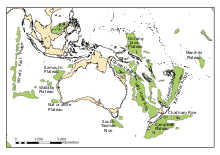
Back هضبة محيطية Arabic Okean platosu Azerbaijani Ozeanisches Plateau German Meseta oceánica Spanish Ookeaniline platoo Estonian فلات اقیانوسی Persian Plateau océanique French Meseta oceánica Galician समुद्री पठार Hindi Plateau oceanico Italian
3°03′S 160°23′E / 3.050°S 160.383°E

An oceanic or submarine plateau is a large, relatively flat elevation that is higher than the surrounding relief with one or more relatively steep sides.[1]
There are 184 oceanic plateaus in the world, covering an area of 18,486,600 km2 (7,137,700 sq mi) or about 5.11% of the oceans.[2] The South Pacific region around Australia and New Zealand contains the greatest number of oceanic plateaus (see map).
Oceanic plateaus produced by large igneous provinces are often associated with hotspots, mantle plumes, and volcanic islands — such as Iceland, Hawaii, Cape Verde, and Kerguelen. The three largest plateaus, the Caribbean, Ontong Java, and Mid-Pacific Mountains, are located on thermal swells. Other oceanic plateaus, however, are made of rifted continental crust, for example the Falkland Plateau, Lord Howe Rise, and parts of Kerguelen, Seychelles, and Arctic ridges.[3] Plateaus formed by large igneous provinces were formed by the equivalent of continental flood basalts such as the Deccan Traps in India and the Snake River Plain in the United States.
In contrast to continental flood basalts, most igneous oceanic plateaus erupt through young and thin (6–7 km (3.7–4.3 mi)) mafic or ultra-mafic crust and are therefore uncontaminated by felsic crust and representative for their mantle sources. These plateaus often rise 2–3 km (1.2–1.9 mi) above the surrounding ocean floor and are more buoyant than oceanic crust. They therefore tend to withstand subduction, more-so when thick and when reaching subduction zones shortly after their formations. As a consequence, they tend to "dock" to continental margins and be preserved as accreted terranes. Such terranes are often better preserved than the exposed parts of continental flood basalts and are therefore a better record of large-scale volcanic eruptions throughout Earth's history. This "docking" also means that oceanic plateaus are important contributors to the growth of continental crust. Their formations often had a dramatic impact on global climate, such as the most recent plateaus formed, the three, large, Cretaceous oceanic plateaus in the Pacific and Indian Ocean: Ontong Java, Kerguelen, and Caribbean.[4]
- ^ IHO 2013, pp. 2–12
- ^ Harris et al. 2014, Plateaus (Supplementary Table 20), p. 16
- ^ Mooney, Laske & Masters 1998, Anomalous Crust: Oceanic Plateaus, Hotspots, and Rifts, pp. 754–755
- ^ Kerr 2013, p. 632
© MMXXIII Rich X Search. We shall prevail. All rights reserved. Rich X Search